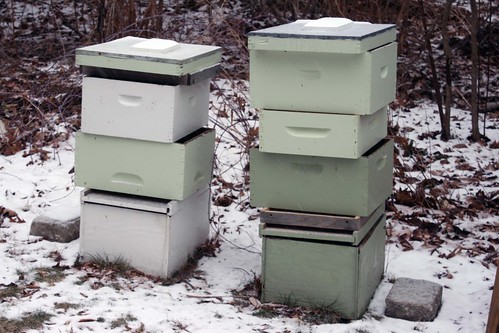
:-( The boxes of both my hives are now empty and stacked crosswise. I was sad to see so many bees die. I'm guessing they died from dripping condensation as I saw water droplets in the hive when I opened it.
I noticed bees begin to die in November, just after it got cold. They fell from the hive in huge numbers. Mostly they couldn't get cleaned out through the mouse guard, so they accumulated on the floor of the hive and I brushed them out. Both hives. I knew it wasn't good.
So, it could have been mites. I've never treated for them, or tested. I've only ever seen one on a dead bee. I know they're mostly in larvae, and they reduce hive numbers. Mites are thought to be a large contributor to colony collapse disorder (CCD), where adult bee populations effectively disappear suddenly, within a few weeks or days. My bees didn't disappear, they were right there - piles of dead ones.
I didn't see signs of any other diseases: foulbrood, nosema, wax moths, or hive beetles. I forgot to call the bee inspector, who probably would have a had a helpful opinion for me.
So I'm going to blame the moisture I saw in the hive. Bees can keep themselves warm but not if they're wet. They vibrate their wings and create heat for the cluster. They can't do this if they have water dripping on them. My hives are located 40-50 ft from a large pond, on pretty much the same level as the pond. We enjoy watching clouds of moisture rise from the pond on cold mornings. They are quite beautiful.
I've been reading about condensation in bee hives and elsewhere (e.g. our new garage ceiling...). If the top of the hive is cold, the inside is warmer, and the humidity is high, water will condense inside the top. Humidity is worse if there is poor air circulation.
I want to give it another try with my hives next year. I'd like to see if I can address condensation and get better winter survival. The only thing I did for it this year was to put insulation (standard ceiling panels) inside the top cover. I have two things I'd like to try next year:
- Move the hives to a higher site, further from the pond. This will be either in my new fruit tree "mini-orchard" on an open south slope 200 ft from the pond and about 30 feet elevation - or in my front yard, twice as far away and twice as high.
- Add a "quilt box". I'm still looking into how to built this. It's essentially a short hive box with a porous bottom filled with absorbent wood shavings and ventilation holes in the sides.
Advice?